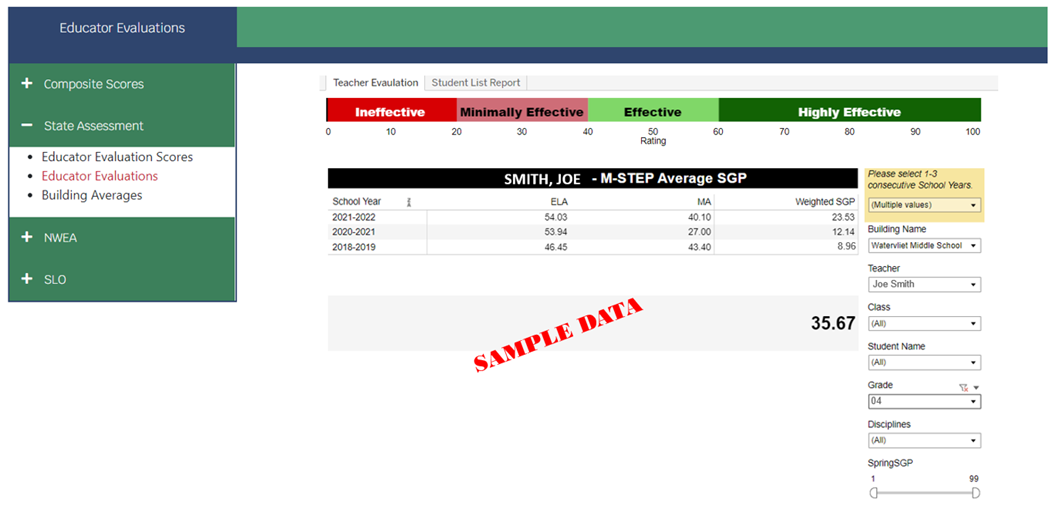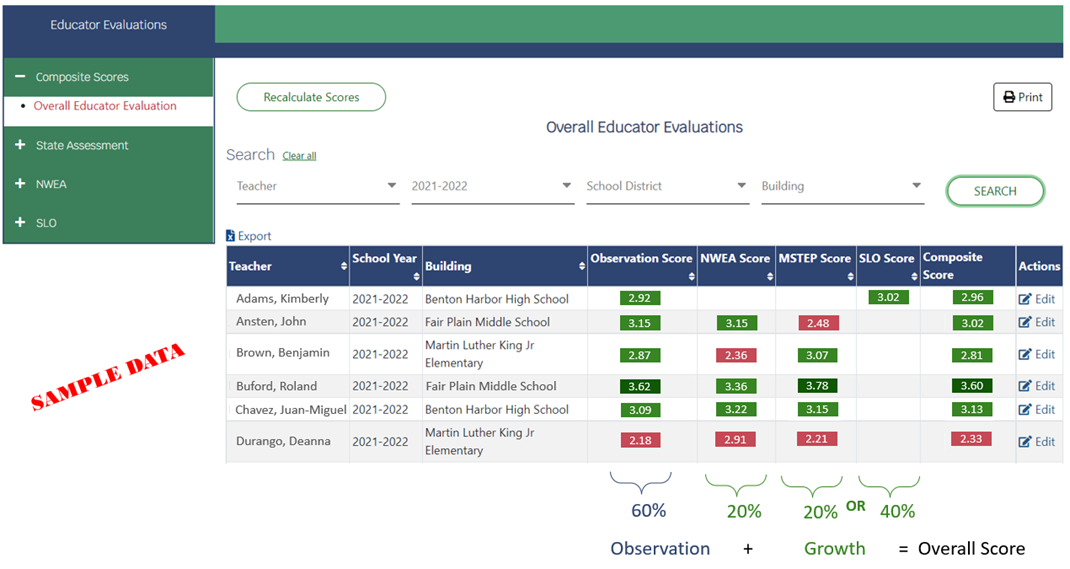The Munetrix Educator Evaluation App uses preloaded assessment data to calculate Student Growth Percentiles (SGP), building average growth, and when observation data is added overall composite evaluation scores.
⏰Estimated Time: 5 minutes
Munetrix Educator Evaluation App
The Munetrix Educator Evaluation app uses the state and local assessment data that the district has already uploaded into Munetrix to effortlessly calculate the growth portion of the educator evaluation score. The growth data is then combined with the observation score to calculate the overall educator evaluation score. The Educator Evaluation app uses the algorithms found in the Michigan Department of Education Growth Calculator spreadsheets. Student growth can be calculated using individual teacher attributions or building averages as described further in this document.

Where the Data Comes From
State and local assessment data for each student in the district is uploaded into the Munetrix system to power several applications, such as the Student Growth Explorer, IRIPs, Needs Assessment, 31a reporting, and the Educator Evaluations app. Students are connected to teachers based on the roster data received from the MI Data Hub or an export file from the school district student’s information system. Listed below are the state and local assessments currently supported by the Munetrix system for Educator Evaluations.
| State Assessments | Local Assessments |
|
M-STEP PSAT SAT |
NWEA MAP Renaissance Learning STAR Curriculum Associates i-Ready DRC Smarter Balance Fastbridge District Created Pre-Post Assessments |
Calculating Growth for an Individual Teacher
Student growth calculated based on individual teacher attribution takes into consideration individual student growth percentiles (SGPs) for students rostered to the teacher over the past three years on state and local assessments. If the teacher has been employed by the district for less than three years, the system uses the data available.
The overall SGP for all students rostered to the teacher for each subject and each year. The overall SGP across all subjects is weighted for each year as outlined below.
Teacher with 3 Years of Data – 50% weight applied to the most recent year overall SGP, 30% weight applied to the second year overall SGP, and 20% applied to the third year overall SGP.
Teacher with 2 Years of Data – 60% weight applied to the most recent year overall SGP and 40% weight applied to the second year overall SGP.
Teacher with 1 Year of Data – 100% weight applied to the most recent year overall SGP.
The weighted overall SGPs are then added up for the overall SGP as shown below.
Adjustments can be made using the filters on the right to remove subjects, if the teacher only teaches one subject, remove individual students or classes, remove grade levels, etc. for a more accurate calculation. Note: When used with local assessment data, typically the student SGP is used if available from the assessment provider. For some assessments, such as the NWEA MAP assessment, the Conditional Growth Percentile (CGP) is used instead.
Calculating Building Averages
Districts may also use a shared attribution to calculate student growth component for educator evaluations. Some districts select to use district, building or grade level averages. While the overall average of the years shown is displayed in the last column, it should not be used to calculated educator evaluation scores. The same weighting as used in individual attributions for three years of data, two years of data, and one year of data based on the teacher’s longevity with the district, would be applied to each educator’s score if using a district, building or grade level average. The Munetrix system displays shared attributions as an average SGP or average educator index score.

Building Averages Displayed as Average Student Growth Percent (SGP)

Building Averages Displayed as Average Educator Index Score
Calculating the Overall Educator Evaluation Index Score
The Munetrix System calculates the overall Educator Evaluation Index score which takes into account both observation and student growth scores based on the requirements outlined by Public Act 173 of 2015 (MCL 380.1249) and the Michigan Department of Education (MDE). Per the legislation, 60% of the overall educator evaluation score comes from the teacher’s observation score during the evaluation school year. 40% of the annual year-end evaluation must be based on student growth and
assessment data.
Teachers who teach grade levels and subject areas measured by state assessments are required to have 20% of their student growth score derived from the state assessment data, per the legislation. The other 20% of the student growth score can be calculated from local assessment data. Teachers who teach non-evaluated subjects or grade levels where the state assessment is not administered, per the legislation, may have all 40% of the growth score calculated from local assessment data.
School districts provide Munetrix with the observation score for each teacher in a CSV or Excel file, which is imported into the Munetrix System. The Munetrix System then uses the observation score and growth data, weighted appropriately per the legislation, to generate the overall educator evaluation index score for each teacher respectively.
The legislation does allow for school districts some flexibility regarding local assessment data and distribution of weights applied if multiple local assessments are applied. The total weight of all local assessments must equal either 20% of the overall educator score, if the teacher is teaching a grade(s) and/or subject(s) that are assessed by state assessments or 40% of the overall educator score if the teacher is not teaching grade(s) or subject(s) assessed by state assessments.
Note: Districts selecting to use multiple local assessments per teacher or a combination of building averages and individual attributions per teacher, additional calculations may need to be performed outside of the Munetrix System.
Educator Effectiveness Index Scale
The Michigan Department of Education recommends use of the following scale for Educator Effectiveness and correlations to percentages for observation scores and student growth percentiles when calculating the overall educator effectiveness score. Munetrix has incorporated the algorithms for converting percentages or student growth percentiles to the recommended educator effectiveness index scale below.

Additional Resources
Michigan Department of Education Guidance for the 2022-2023 School Year
Educator Evaluation At-A-Glance Guide (Michigan Department of Education)
Measuring Student Growth for Educator Evaluation (Michigan Department of Education)
Student Growth Percentiles (Michigan Department of Education)
